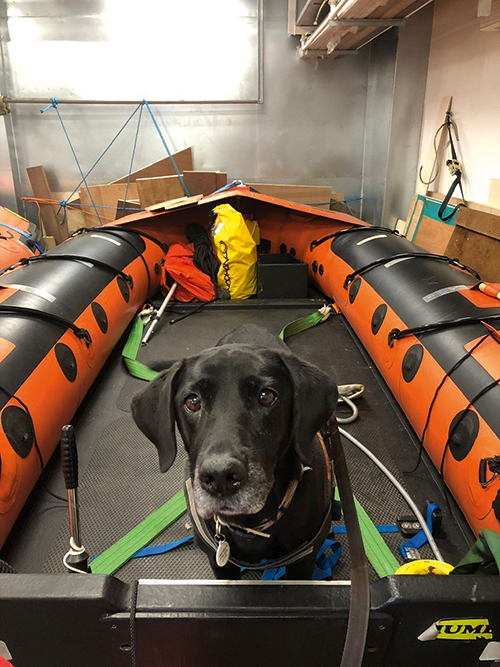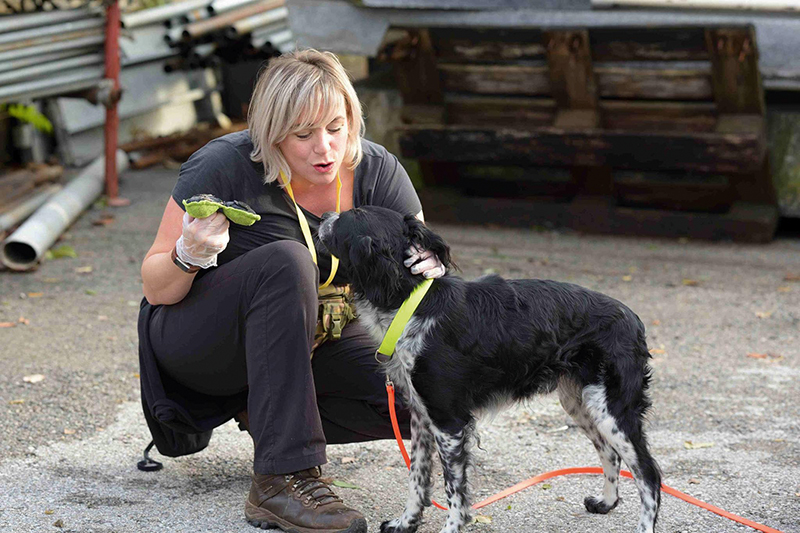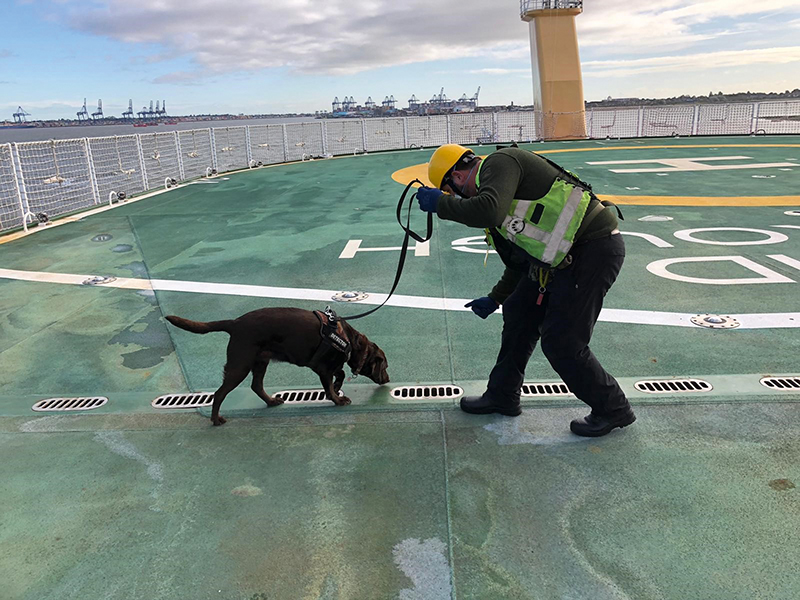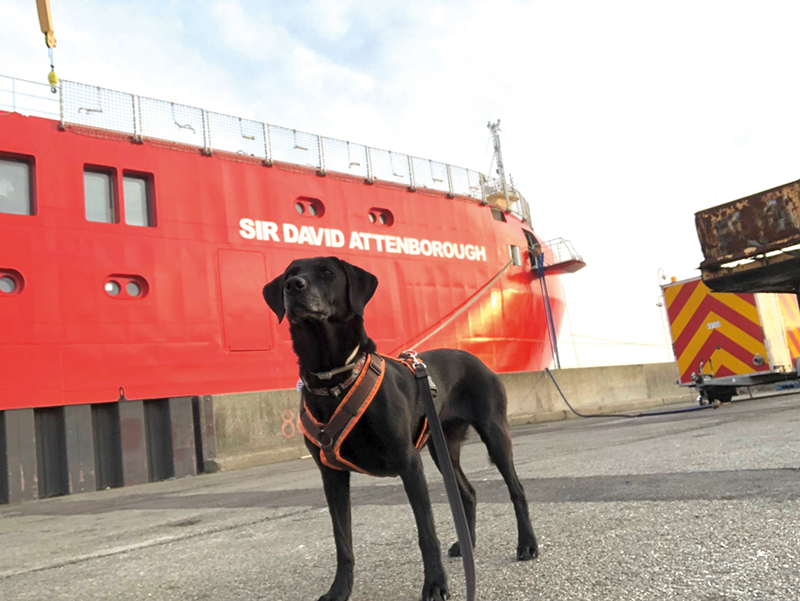We’re more aware than ever of the need to protect our environment and avoid further climate change. Julie Hill reports on the dogs who are helping in that essential endeavour.
The Royal Research Ship (RRS) Sir David Attenborough is at the forefront of British polar research, and it is a huge ship.
This state-of-the-art vessel is 129 metres long and 24 metres wide, weighing in at 15,000 tonnes. It can stay at sea for 60 days, has a crew of 30, with accommodation for up to 60 scientists and support staff. Able to break through up to one-metre-thick ice, it can also launch and recover aerial and ocean robotic systems.
With many facilities never before seen on a British ship, the craft will allow scientists to study the ocean, sea floor, ice, and atmosphere, and carries with it the hope and expectations of many.
However, just one tiny mouse on board this vast vessel could scupper its vital mission. With such an array of hiding places for tiny creatures, finding vermin on board is like looking for a needle in a haystack, so how do you find them? Turn to another creature, of course, to sniff them out!

Searching the whole ship and its supplies was a mammoth task.
A team of highly trained detection dogs and handlers stand between the cutting edge craft and potential ecological disaster.
Rodent stowaways arrived in South Georgia (the Sir David Attenborough’s first destination as it carries out important scientific research with the British Antarctic Survey) aboard whaling and seal hunting ships, and had a detrimental effect on land-nesting birds on the island. After a huge campaign, South Georgia has been declared rodent-free. The birds are returning, and their future must be safeguarded.
Louise Wilson, founder of Conservation K9 Consultancy, was the woman tasked with ensuring the Sir David Attenborough was rodent-free before it left for the southern Atlantic Ocean; the team spent two weeks on board the ship.

Louise trains all her dogs using kind, reward-based methods.
“We’ve been working with Working Dogs for Conservation for over two years, and ours are the only dogs certified by them in the UK,” explained Louise. “We were given the project of training bio-security detection dogs for vermin detection on any vessels that head into South Georgia, and we were the first detection dogs ever on the Sir David Attenborough.”
The task was a complex one as the dogs must only react to fresh odour. Some of the cargo has been in storage for two years, and rats may have accessed it during that time. Rather than reacting to this vintage odour, Louise’s dogs must only fully indicate to fresh odour, as this is the only way to know whether rats are actually on board the ship.
“We’ve got three lovely trained dogs, Labradors Luna and Fidget, and Cocker Spaniel Gem, and we’re probably going to train more because we’re getting enquiries about doing other island searches to make sure they’re free of vermin. People are definitely realising it is an important requirement,” said Louise.
Searching and sniffing is demanding for dogs, and Louise makes their welfare a priority. “We’ve got a very strict working directive. We like to work on a rotation of 20 minutes on, and at least 20 minutes off. It’s not just physical fatigue the dog goes through, it’s nasal fatigue — sniffing can take a lot of energy. That’s why we’ve got multiple dog teams; one dog works while the other two rest. This ensures the dogs’ efficacy, as well as their well-being.”

Louise and her team train dogs for vermin detection on any vessels heading for South Georgia.
Louise and her team must be aware of the dog’s emotional state as they search, because sniffing can become too arousing for them. “If you let a dog become
over-aroused, it can take five or six days for them to get back down to base level.”
Each handler must be expertly trained to read the dog they are working with, to be able to interpret their body language and know what the dog is sniffing. “During our discrimination trials, if the dog goes to old odour and shows interest, we don’t discourage that. We don’t do a non-reward marker, but we mark in our heads that that’s the dog’s reaction to very old odour. That gives us a real understanding of our dogs. When we’re searching, the dog might show interest in an area so we know at some point there have been rats there. But we don’t want a full-blown indication from our dogs there; we only want a full indication from our dogs on the purest, freshest odour,” Louise explained.

A ship heads into Stromness on South Georgia.
Amazingly, Louise’s dogs can each carry out the same amount of work it would otherwise take 10 people to do. Luckily, dogs find sniffing a very rewarding activity, so the work is not a chore for them. Scent work causes lots of ‘feel good’ chemicals to be released in the canine brain.
Although Louise’s dogs are spearheading efforts to ensure vessels are rodent-free, there is absolutely no predatory response involved. “At no point are we training them to hunt down or kill rats. We’re talking about dogs who are trained specifically to detect the live presence of rats within the last two weeks,” she explained.
Although the dogs are simply following their instincts, and enjoying themselves as they do, their role is vital. Louise emphasised: “We’re talking about making sure animals don’t go extinct.” With so much at stake, it’s good to know that such an important aspect of conservation work is in safe hands — and paws.
Louise’s dogs were the first detection dogs on the RSS Sir David Attenborough.
What makes a detection dog?
All Louise’s dogs are rescues, and she usually asks the shelter for the dogs who would not make ‘good’ pets. This is to avoid taking a dog who would fit well into pet life; conservation dogs need drive and determination, qualities which can cause issues in a family pet. Louise’s dogs also need to adapt to a fairly unusual way of life. Whereas many dogs like routine, a detection dog’s life can be unpredictable. They may have to wake up in the middle of the night and perform searches in the dark. “They have to get used to travelling a lot, going into different environments and places. Our dogs have to be happy with spontaneity,” confirmed Louise.
Searching on the RRS Sir David Attenborough came with additional challenges, and Louise works hard to ensure her dogs are comfortable with these.
“They need to get used to the water’s edge, and being craned into the hull. A lot of the floor surfaces are grids which their feet will go through, so the dogs have to wear booties to protect their paws.
“They have to be able to climb around the vessel without running around crazily, and to be controlled without becoming demoralised. This is such a big ship — there are helipads, helicopter hangars, and so many different decks to it. It’s not always just about the odour with detection dogs, it’s about everything else in their environment too.”
Find out more at:
● Conservation K9 Consultancy; https://www.conservationk9consultancy.com
● Working Dogs for Conservation; https://wd4c.org
● You can keep track of the RRS Sir David Attenborough at https://www.rmg.co.uk/stories/topics/rrs-sir-david-attenborough/current-location-ship-tracking








